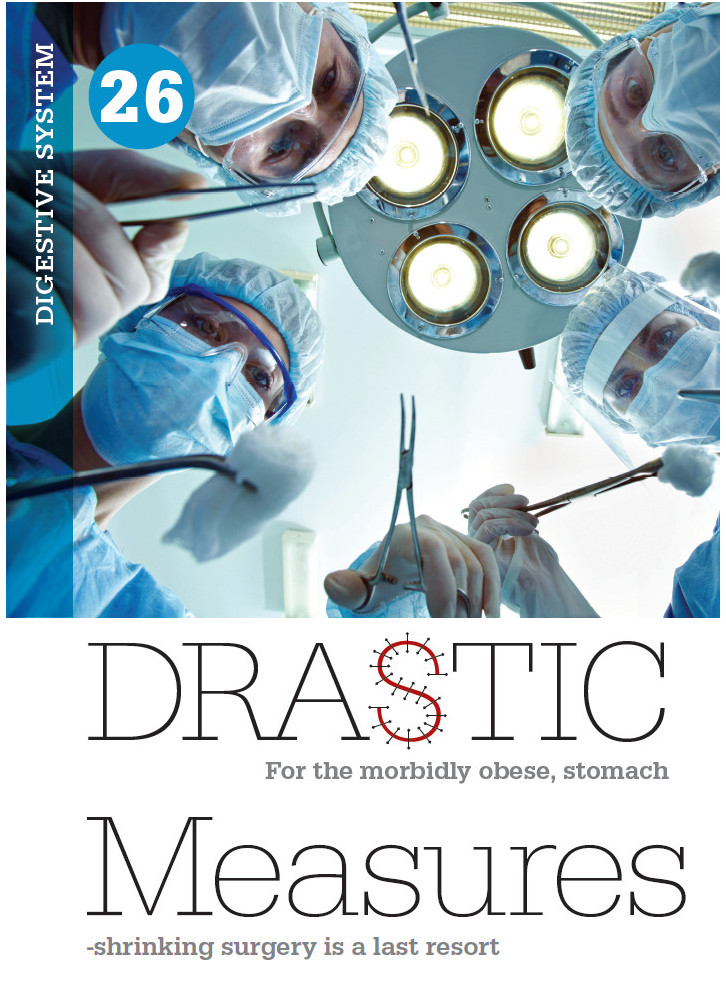568

569
DRIVING QUESTIONS
- What is the anatomy of the digestive system?
- How is food broken down and utilized as it moves through the digestive tract?
- What are the risks and benefits of bariatric surgery?
In-Class Activity
Click here to access Lecture ppt specifically designed for chapter 26.
Click here to access Clicker Questions specifically designed for chapter 26.
 MY JO SMITH HARDLY RECALLS A TIME GROWING UP when her family wasn’t dieting. Her parents were both obese, and they were always trying to lose weight.
MY JO SMITH HARDLY RECALLS A TIME GROWING UP when her family wasn’t dieting. Her parents were both obese, and they were always trying to lose weight.
Smith herself was relatively slender until her senior year in high school, when her weight began to creep up. She grew up on a horse farm in northeast Maryland, and as a teenager spent much of her spare time on the road, taking her horses to shows. She attributes her weight gain to a diet that consisted primarily of fast food. “I was always eating on the run,” says Smith, now 38 years old and a computer literacy teacher. But, she says, her growing girth “never stopped me from doing the things I wanted to do.” The extra weight did bother her, though, and she tried several diets and diet pills, only to see her weight yo-yo up and down.
In 2004, at a routine checkup, Smith’s doctor noticed that she suffered a number of ills that were likely caused by Smith’s 264-pound weight. For one thing, she had been suffering from migraines. She also had stress incontinence—a bladder that leaked when stressed by coughing or laughing, for example. “I thought that was just normal,” she says. And she went months at a time without having a period—a telltale sign of a hormonal imbalance often associated with obesity. Smith’s physician suggested that, to lose weight, Smith consider having a surgical procedure that would shrink her stomach to the size of a golf ball—a drastic measure, but one that her doctor believed was warranted given the health complications caused by Smith’s weight.
570
Studies show that even 10 years after surgery, most patients still weigh 25% to 30% less than they did before the surgery.
Though we often use the word “fat” casually, obesity—having too much body fat—is actually a medical condition. Obesity is defined as weighing 20% or more than one’s “ideal” body weight (based on insurance tables of death rates) or having a body mass index (BMI) of 30 or higher (see Chapter 6). Morbid obesity—sometimes called clinically severe obesity—is defined as being 100 pounds or more overweight or having a BMI of 40 or higher. Obesity becomes “morbid” when it significantly increases the risk of one or more obesity-related health conditions or serious diseases, such as heart disease and diabetes. At 5′ 2″, and with a BMI of 48, Smith had become morbidly obese.

Even then, Smith had a hard time accepting that she needed such a drastic method to lose weight. “At first I thought he was a quack,” she says of her doctor. But she began to think more about the surgery after a friend underwent the stomach-shrinking surgery with dramatic results.
There are several types of bariatric, or weight-loss, surgery. (“Bariatric” comes from the Greek baros, meaning “heaviness.”) All involve surgically reducing the size of the stomach, either temporarily or permanently. The specific type of surgery recommended depends on the individual patient’s medical history and weight-loss goal. Because there are many associated risks, a National Institutes of Health panel of experts has recommended surgery only for people considered morbidly obese—people whose risk of death from diabetes or heart disease because of excess weight is five to seven times greater than for those of average weight.
But bariatric surgery is no miracle cure. “It’s sort of barbaric,” says Monica Skarulis, director of the Metabolic Clinical Research Unit at the National Institutes of Health. Because the surgery so drastically reduces the size of the stomach and restricts how much a person can eat, it amounts to “forced behavior control,” since patients must live on a strict diet, she says. If they overeat, they suffer nasty side effects such as vomiting and diarrhea. On top of that, some gastric bypass patients suffer mineral and vitamin deficiencies over the long term that cause bone loss and potentially other health impairments. And the surgery itself is risky: as many as 20% of patients suffer complications a year after the surgery that are severe enough to put them back in the hospital.
571
For some morbidly obese people, however, the risk of dying from obesity-related diseases is higher than the risk of surgical complications. And in terms of weight reduction, the surgery is more effective than lifestyle changes alone. Almost all patients lose 30% to 50% of their excess weight in the first 6 months and 77% of their excess weight after about a year. Studies show that even 10 years after surgery, most patients still weigh 25% to 30% less than they did before the surgery. Consequently, demand for the surgery has soared in the United States since the early 2000s, peaking at about 220,000 surgeries a year.